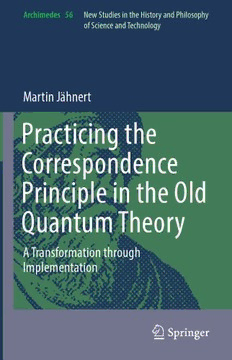
Practicing the Correspondence Principle in the Old Quantum Theory. A Transformation through Implementation PDF
Preview Practicing the Correspondence Principle in the Old Quantum Theory. A Transformation through Implementation
Archimedes 56 New Studies in the History and Philosophy of Science and Technology Martin Jähnert Practicing the Correspondence Principle in the Old Quantum Theory A Transformation through Implementation Archimedes NEWSTUDIESINTHEHISTORYANDPHILOSOPHY OFSCIENCEANDTECHNOLOGY VOLUME56 EDITOR JEDZ.BUCHWALD,DreyfussProfessorofHistory,CaliforniaInstitute ofTechnology,Pasadena,USA ASSOCIATEEDITORSFORMATHEMATICSANDPHYSICALSCIENCES JEREMYGRAY,TheFacultyofMathematicsandComputing, TheOpenUniversity,UK TILMANSAUER,JohannesGutenbergUniversityMainz,Germany ASSOCIATEEDITORSFORBIOLOGICALSCIENCES SHARONKINGSLAND,DepartmentofHistoryofScienceandTechnology, JohnsHopkinsUniversity,Baltimore,USA MANFREDLAUBICHLER,ArizonaStateUniversity,USA ADVISORYBOARDFORMATHEMATICS,PHYSICALSCIENCESANDTECHNOLOGY HENKBOS,UniversityofUtrecht,TheNetherlands MORDECHAIFEINGOLD,CaliforniaInstituteofTechnology,USA ALLAND.FRANKLIN,UniversityofColoradoatBoulder,USA KOSTASGAVROGLU,NationalTechnicalUniversityofAthens,Greece PAULHOYNINGEN-HUENE,LeibnizUniversityinHannover,Germany TREVORLEVERE,UniversityofToronto,Canada JESPErLÜTZEN,CopenhagenUniversity,Denmark WILLIAMNEWMAN,IndianaUniversity,Bloomington,USA LAWRENCEPRINCIPE,TheJohnsHopkinsUniversity,USA JÜRGENRENN,MaxPlanckInstitutefortheHistoryofScience,Germany ALEXROLAND,DukeUniversity,USA ALANSHAPIRO,UniversityofMinnesota,USA NOELSWERDLOW,CaliforniaInstituteofTechnology,USA ADVISORYBOARDFORBIOLOGY MICHAELDIETRICH,DartmouthCollege,USA MICHELMORANGE,CentreCavaillés,EcoleNormaleSupèrieure,France HANS-JÖRGRHEINBERGER,MaxPlanckInstitutefortheHistoryofScience,Germany NANCYSIRAISI,HunterCollegeoftheCityUniversityofNewYork,USA Archimedeshasthreefundamentalgoals;tofurthertheintegrationofthehistoriesofscienceand technologywithoneanother:toinvestigatethetechnical,socialandpracticalhistoriesofspecific developmentsinscienceandtechnology;andfinally,wherepossibleanddesirable,tobringthe historiesofscienceandtechnologyintoclosercontactwiththephilosophyofscience.Tothese ends,eachvolumewillhaveitsownthemeandtitleandwillbeplannedbyoneormoremembers oftheAdvisoryBoardinconsultationwiththeeditor.Althoughthevolumeshavespecificthemes, theseriesitselfwillnotbelimitedtooneoreventoafewparticularareas.Itssubjectsincludeany ofthesciences,rangingfrombiologythroughphysics,allaspectsoftechnology,broadlyconstrued, aswellashistorically-engagedphilosophyofscienceortechnology.Takenasawhole,Archimedes willbeofinteresttohistorians,philosophers,andscientists,aswellastothoseinbusinessand industrywhoseektounderstandhowscienceandindustryhavecometobesostronglylinked. Moreinformationaboutthisseriesathttp://www.springer.com/series/5644 ¨ Martin Jahnert Practicing the Correspondence Principle in the Old Quantum Theory A Transformation through Implementation 123 MartinJa¨hnert Institutfu¨rPhilosophie,Literatur-, Wissenschafts-undTechnikgeschichte FachbereichWissenschaftsgeschichte, TechnischeUniversita¨tBerlin Berlin,Germany MaxPlanckInstitute fortheHistoryofScience Berlin,Germany Zugl.Berlin,TechnischeUniversität,Diss.,2016 ISSN1385-0180 ISSN2215-0064 (electronic) Archimedes ISBN978-3-030-13299-6 ISBN978-3-030-13300-9 (eBook) https://doi.org/10.1007/978-3-030-13300-9 LibraryofCongressControlNumber:2019933897 ©SpringerNatureSwitzerlandAG2019 Thisworkissubjecttocopyright.AllrightsarereservedbythePublisher,whetherthewholeorpartof thematerialisconcerned,specificallytherightsoftranslation,reprinting,reuseofillustrations,recitation, broadcasting,reproductiononmicrofilmsorinanyotherphysicalway,andtransmissionorinformation storageandretrieval,electronicadaptation,computersoftware,orbysimilarordissimilarmethodology nowknownorhereafterdeveloped. Theuseofgeneraldescriptivenames,registerednames,trademarks,servicemarks,etc.inthispublication doesnotimply,evenintheabsenceofaspecificstatement,thatsuchnamesareexemptfromtherelevant protectivelawsandregulationsandthereforefreeforgeneraluse. Thepublisher,theauthors,andtheeditorsaresafetoassumethattheadviceandinformationinthisbook arebelievedtobetrueandaccurateatthedateofpublication.Neitherthepublishernortheauthorsor theeditorsgiveawarranty,expressorimplied,withrespecttothematerialcontainedhereinorforany errorsoromissionsthatmayhavebeenmade.Thepublisherremainsneutralwithregardtojurisdictional claimsinpublishedmapsandinstitutionalaffiliations. ThisSpringerimprintispublishedbytheregisteredcompanySpringerNatureSwitzerlandAG. Theregisteredcompanyaddressis:Gewerbestrasse11,6330Cham,Switzerland Acknowledgments It is a pleasure to have the opportunity to acknowledge and to thank those who generously havesupportedandwhohaveaccompanied meinmyresearchforthis book. I thank Friedrich Steinle at the Technische Universität Berlin and Jürgen Renn at the Max Planck Institute (MPI) for the History of Science, Berlin, for theiradviceandsupportinallstagesofmydissertation.Theirconstantintellectual as well as institutional support, their personal encouragement and their patience made this book possible. I thank Alexander S. Blum with whom I discussed the book in its various stages during countless reading sessions and lunch breaks. His detailed comments on the entire manuscript have been much enjoyed and equally appreciated. Likewise,conversationsandheateddebatesintheproject“HistoryandFounda- tionsofQuantumPhysics”havegivenmeinvaluablefoodforthought.Especially, I want to thank Christoph Lehner and Christian Joas. Furthermore, I am grateful forthecountlessdiscussionswithmycolleaguesintheproject“HistoryandFoun- dations of Quantum Physics” and at the Technische Universität Berlin. I want to thankFinnAaserud,GuidoBacciagaluppi,MassimilianoBadino,AriannaBorrelli, Elise Crull, Anthony H. Duncan, Michael Eckert, Markus Ehberger, Clayton A. Gearhart,DieterHoffmann,JeremiahJames,MichelJanssen,MartaJordiTaltavull, ShaulKatzir,RobertoLalli,DanielaMonaldi,JaumeNavarro,RobertRynasiewicz, MatthiasSchemmel,SumanSeth,andAdrianWüthrich.IalsowanttothankJohn Heilbron,SúliSigurdsson,AnketeHeesen,andeveryoneelsewhohasattendedone ofmytalksorreadpartsofmymanuscript.IthankmyeditorJedZ.Buchwaldfor includingmeintheseriesArchimedes.HeandTilmanSauerprovidedthoroughand helpfulfeedbackonmymanuscript,forwhichIamdeeplygrateful. Financialsupportfromseveralorganizationsallowedmetowritemydissertation andthenturnitintothisbook.IwanttothanktheMaxPlanckSocietyandJürgen Renn’s Department I at the MPI for the History of Science for a predoctoral scholarship and for a wrap-up position, the German-Israeli Foundation for a pre- doctoralscholarship,theBerlinCenterfortheHistoryofScienceforapostdoctoral fellowship, as well as the American Institute of Physics, the History of Science Society,andtheGermanAcademicExchangeService(DAAD)fortravelgrants. v vi Acknowledgments Iamgratefulfortheauthorizationtoconsultarchivesandtopublishquotations from holdings of American Philosophical Society (Philadelphia), the Niels Bohr Archive(Copenhagen),UniversityofChicagoLibrary,Albert-Ludwigs-Universität Freiburg,NiedersächsischeStaats-undUniversitätsbibliothekGöttingenandarchive of the Deutsches Museum (Munich). I thank Urs Schoepflin, Esther Chen, Ellen Garske, Ruth Kessentini, Matthias Schwerdt, and all other members or former members of staff at the MPI’s library for their invaluable work. Similarly, I am gratefultotheterrificadministrative,linguisticanddiplomaticsupportfromLindy Divarci,PetraSchröter,ShadiyeLeather-Barrow,andNinaKrampitz. Last but not least, I wish to thank my parents, family and friends for their unconditionalsupport.Forawhile,AlrunandIanticipatedthatourson’sfirstword might be “Korrespondenzprinzip” – it wasn’t; however, 2-year-old Anton found his own clever comment on the topic, which might have amused one or the other protagonist in this story, too: “Das mag ich nicht. Da ist Prinzip drin.” Thank you forthisandeverythingelse. Contents 1 Introduction .................................................................. 1 1.1 QuantumPhysicsinthe1920s:ThePatchworkofProblems, ResearchToolsandtheState-TransitionModel....................... 2 1.2 TheCorrespondencePrincipleintheHistoriographyofthe OldQuantumTheory ................................................... 4 1.3 Sources .................................................................. 8 1.4 TheArgument........................................................... 9 2 The Correspondence Principle in Copenhagen 1913–1923: Origin,FormulationandConsolidation................................... 13 2.1 FormulatingtheProblem,PartI:TheState-TransitionModel andtheRelationBetweenRadiationandMotion...................... 14 2.2 FormulatingtheProblem,PartII:TheState-TransitionModel andtheRadiationProcessinQuantumTheory........................ 23 2.3 Bohr’sAdaptive(Re-)Formulation:TheEmergenceofthe CorrespondencePrinciple(1916–1918) ............................... 29 2.4 ConsolidationandExtensionoftheCorrespondencePrinciple (1919–1923)............................................................. 42 2.5 Conclusion .............................................................. 50 3 TheCorrespondencePrincipleintheQuantumNetwork 1918–1926..................................................................... 53 3.1 From Reception to Adaptation: Paraphrases of the CorrespondencePrinciple1918–1926 ................................. 54 3.2 The Dissemination of the Correspondence Principle: PreliminaryConsiderations............................................. 60 3.3 Conclusion .............................................................. 67 4 UsingtheMagicWand:Sommerfeld,MultipletIntensitiesand theCorrespondencePrinciple.............................................. 69 4.1 FormulatingtheProblem:TheGesetzmäßigkeitenofMultiplet SpectraandTheirModelInterpretation................................ 71 vii viii Contents 4.2 ImplementingtheCorrespondencePrinciple:Heisenberg’s ModelInterpretationandSommerfeld’sIntensityRule............... 75 4.3 RecognizingProblems:Sommerfeld,HeisenbergandtheTotal IntensityofSplit-upLines.............................................. 95 4.4 AdaptiveReformulation:Sommerfeld,Hönlandthe“Theory ofIntensities”............................................................ 98 4.5 Conclusion .............................................................. 122 5 FertilizeronaSandyAcreage:Franck,HundandtheRamsauer Effect .......................................................................... 127 5.1 FormulatingtheProblem:Franck,Hundandthe“ArgonEffect”..... 129 5.2 ImplementingtheCorrespondencePrinciple:Franck,Hund andtheNon-deflectionHypothesis..................................... 136 5.3 RecognizingProblems:HundandtheEstimateofTransparency..... 150 5.4 Adaptive Reformulation: Franck, Hund and the State-TransitionModelforScattering.................................. 153 5.5 Conclusion .............................................................. 161 6 ThatICannotConceiveofAftertheResultsofYourDissertation: FritzReicheandtheF-sumRule........................................... 165 6.1 FormulatingtheProblem:Ladenburg,ReicheandtheNumber ofDispersionElectrons................................................. 166 6.2 Implementing the Correspondence Principle: Reiche, LadenburgandtheDeterminationofTransitionProbabilities........ 171 6.3 Recognizing Problems: Reiche and the Comparison of AbsorptioninClassicalandQuantumTheory......................... 181 6.4 AdaptiveReformulation:Reiche,ThomasandtheF-sumRule ...... 192 6.5 Conclusion .............................................................. 205 7 CopenhagenReactions:TheIntensityProbleminCopenhagen, 1924–1925..................................................................... 211 7.1 DefendingtheCorrespondencePrinciple:TheSumRulesin Copenhagen ............................................................. 213 7.2 ReformulatingtheIntensityProblem:TheVanishingAtthe EdgesArgumentinCopenhagen....................................... 222 7.3 Pauli,Heisenberg,andKronigandtheSearchforaQuantum Kinematics............................................................... 227 7.4 TheIntensityProblemandHeisenberg’sUmdeutung................. 238 7.5 Conclusion .............................................................. 248 8 Conclusion.................................................................... 255 8.1 TheCorrespondencePrincipleandthePatchworkofProblems ...... 256 8.2 TransformationThroughImplementation:TheConceptual DevelopmentoftheCorrespondencePrinciple........................ 263 Contents ix A ApplicationsoftheCorrespondencePrinciple,1918–1928.............. 271 Archives........................................................................... 275 References......................................................................... 277 Index............................................................................... 289
